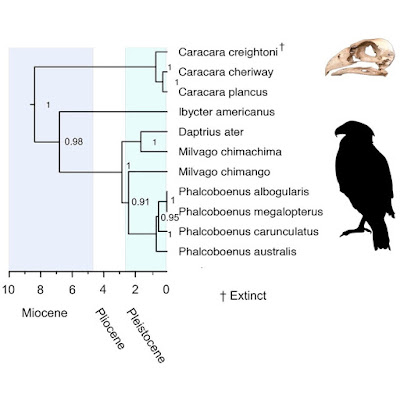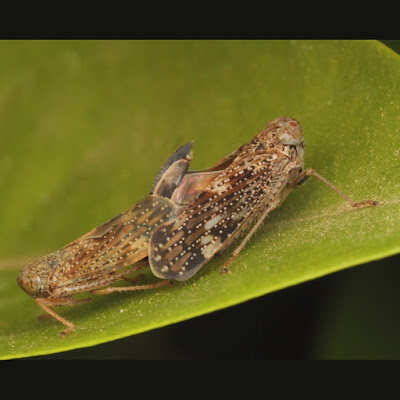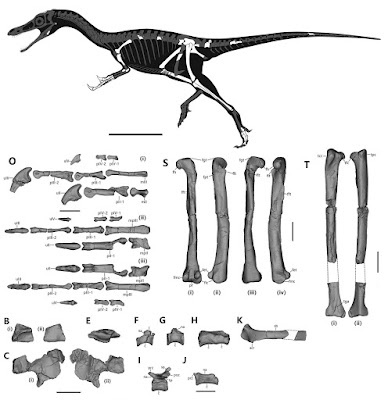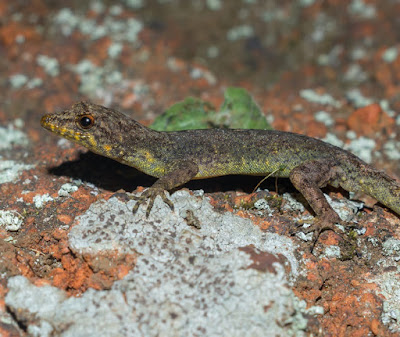[Most Recent Entries] [Calendar View]
Wednesday, August 14th, 2019
| Time | Event | ||||
| 8:04a | [Ornithology • 2019] Ancient DNA from A 2,500-year-old Caribbean Fossil Places An Extinct Bird (Caracara creightoni) in A Phylogenetic Context
Highlights: • New methods and unique fossil sites offer potential to recover tropical bird aDNA. • The bird, Caracara creightoni, went extinct upon human arrival in the Caribbean. • We obtained mitochondrial genome data from C. creightoni. • Caracara creightoni was sister to the two extant continental Caracara species. • It shared a common ancestor with extant species during the Pleistocene. Abstract Since the late Pleistocene humans have caused the extinction of species across our planet. Placing these extinct species in the tree of life with genetic data is essential to understand the ecological and evolutionary implications of these losses. While ancient DNA (aDNA) techniques have advanced rapidly in recent decades, aDNA from tropical species, especially birds, has been historically difficult to obtain, leaving a gap in our understanding of the extinction processes that have influenced current distributions and biodiversity. Here we report the recovery of a nearly complete mitochondrial genome from a 2,500 year old (late Holocene) bone of an extinct species of bird, Caracara creightoni, recovered from the anoxic saltwater environment of a blue hole in the Bahamas. Our results suggest that this extinct species is sister (1.6% sequence divergence) to a clade containing the extant C. cheriway and C. plancus. Caracara creightoni shared a common ancestor with these extant species during the Pleistocene (1.2-0.4 MYA) and presumably survived on Cuba when the Bahamas was mostly underwater during Quaternary interglacial intervals (periods of high sea levels). Tropical blue holes have been collecting animals for thousands of years and will continue to improve our understanding of faunal extinctions and distributions. In particular, new aDNA techniques combined with radiocarbon dating from Holocene Bahamian fossils will allow us to place other extinct (species-level loss) and extirpated (population-level loss) vertebrate taxa in improved phylogenetic, evolutionary, biogeographic, and temporal contexts. Keywords: aDNA, Bahamas, Extinction, Falconiformes, Holocene fossils
Jessica A. Oswald, Julia M. Allen, Kelsey E. Witt, Ryan A. Folk, Nancy A. Albury, David W. Steadman and Robert P. Guralnick. 2019. Ancient DNA from A 2,500-year-old Caribbean Fossil Places An Extinct Bird (Caracara creightoni) in A Phylogenetic Context. Molecular Phylogenetics and Evolution. DOI: 10.1016/j.ympev.2019.106576 | ||||
| 8:29a | [Entomology • 2019] Leafhopper tribe Coelidiini (Hemiptera: Cicadellidae: Coelidiinae) of the Indian Subcontinent Abstract Genera and species of the tribe Coelidiini from the Indian subcontinent are reviewed. Glaberana Nielson, Webbolidia Nielson and Zhangolidia Nielson are recorded from India for the first time. Twenty-three new species are described and illustrated as follows: Calodia deergha sp. nov. (India: Tamil Nadu), C. keralica sp. nov. (India: Kerala), C. kumari sp. nov. (India: Karnataka), C. neofusca sp. nov. (India: Karnataka, Kerala), C. periyari sp. nov. (India: Kerala), C. tridenta sp. nov. (India: Kerala), Glaberana acuta sp. nov. (India: Meghalaya), G. purva sp. nov. (India: Manipur), Olidiana lanceolata sp. nov. (India: Sikkim), O. flectheri sp. nov. (India: Meghalaya), O. umroensis sp. nov. (India: Meghalaya), O. unidenta sp. nov. (India: Assam, West Bengal), Singillatus parapectitus sp. nov. (India: Arunachal Pradesh), S. serratispatulatus sp. nov. (India: Manipur, Meghalaya, Mizoram), Trinoridia dialata sp. nov. (India: Andhra Pradesh, Karnataka, Maharashtra), T. ochrocephala sp. nov. (India: Kerala), T. piperica sp. nov. (India: Karnataka, Kerala, Tamil Nadu), T. ramamurthyi sp. nov. (India:Karnataka, Kerala, Maharashtra), T. saraikela sp. nov. (India: Jarkhand), T. timlivana sp. nov. (India: Uttarakhand), Webbolidia andamana sp. nov. (India: Andaman & Nicobar), W. burmanica sp. nov. (Myanmar: Lashio) and Zhangolidia weicongi sp. nov. (India: Manipur). Olidiana brevis (Walker), O. perculta (Distant) and Trinoridia tripectinata (Nielson) are recorded for the first time from India and also Glaberana khasiensis (Rao) comb. nov. is proposed. Keys to genera and species with a check-list, distribution and host records are included. Keywords: Hemiptera, Host plants, distribution, keys, Auchenorryncha, morphology, checklist Trinoridia ramamurthyi sp. nov. C. A. Viraktamath and Naresh M. Meshram. 2019. Leafhopper tribe Coelidiini (Hemiptera: Cicadellidae: Coelidiinae) of the Indian Subcontinent. Zootaxa. 4653(1); 1-91. DOI: 10.11646/zootaxa.4653.1.1 | ||||
| 9:50a | [Paleontology • 2019] Shishugounykus inexpectus • A New Alvarezsaurian Theropod from the Upper Jurassic Shishugou Formation of western China
Abstract Alvarezsaurian dinosaurs, a group of bizarre theropods with greatly shortened and modified forelimbs, are known mostly from the Cretaceous of Asia and South America. Here we report a new alvarezsaurian, Shishugounykus inexpectus gen. et sp. nov., based on a specimen recovered from the Middle–Upper Jurassic Shishugou Formation of the Junggar Basin, western China. Together with two other alvarezsaurians from this formation, i.e., Haplocheirus sollers and Aorun zhaoi, these Shishugou forms represent the only known Jurassic alvarezsaurians worldwide. Similar to the two other Shishugou alvarezsaurians, this new alvarezsaurian displays early stages in the development of the highly modified alvarezsaurian forelimb, but it possesses a number of manual features closer to the typical coelurosaurian theropod condition. Combining morphological and histological features, our analysis indicates that the earliest known alvarezsaurians are variable in size and other important morphological features, and in particular display a mosaic distribution of forelimb features. Systematic palaeontology Theropoda Marsh, 1881 Maniraptora Gauthier, 1986 Alvarezsauria Bonaparte, 1991 Shishugounykus inexpectus gen. et sp. nov Etymology: The generic name is a combination of Shishugou (Chinese Mandarin for the formation which produced the holotype specimen of the new animal; translates as “rock” “tree” “wash” for the abundant petrified wood in the formation) and onyx (Greek, “claw); the specific name refers to the unexpected discovery of a new alvarezsaurian species from the Middle-Late Jurassic Shishugou Formation, which has produced fossils of two other Jurassic alvarezsaurians, i.e., Haplocheirus sollers and Aorun zhaoi. Holotype: IVPP V23567, a partial skeleton (Fig. 1) including several cranial elements (possible partial right frontal and partial right parietal, partial left frontal, partial right angular, and right articular), three dorsal vertebrae, four sacral vertebrae, three caudal vertebrae, partial right scapula, partial left humerus, partial right ulna and radius, nearly complete right manus, partial left ilium, ischium, and pubis, complete right femur, partial left femur, nearly complete left and right tibiae, partial left and right fibula, a distal tarsal, partial left metatarsals II and III, left pedal phalanges III-1 and 2, IV-1, 2, and 4, and a few rib fragments and unidentifiable pieces. All recovered bones are clearly from one individual given that they are preserved in a small area (about 0.2 square meters), without any other bone nearby. Diagnosis: Shishugounykus inexpectus differs from all other alvarezsaurians in having the following unique combination of features (* marks the autapomorphies; we use the II-III-IV identity of manual digits in tetanurans): supratemporal fossa occupying large portion of frontal and with indistinct anterior border (sharp anterior border in early-branching alvarezsaurians such as Haplocheirus sollers and supratemporal fossa occupying a small portion of frontal in late-branching alvarezsaurians); scapula with hollow acromial process but without lateral concavities*; humeral internal tuberosity mediolaterally constricted distally*, giving it a “pinched” appearance; metacarpal III straight in dorsal view (laterally bowed in most other alvarezsaurians including Haplocheirus sollers); ungual III-3 subequal in size to ungual II-2 (considerably smaller in most other alvarezsaurians including Haplocheirus sollers); iliac medial surface with step-wise transition from ischial peduncle to pubic peduncle*; distal end of metatarsal II asymmetrically ginglymoid*. Locality and Horizon: Wucaiwan, Junggar Basin, Xinjiang, People’s Republic of China, Middle-Upper Jurassic Shishugou Formation34,35,36,37. The holotype-fossil-bearing bed is located between two volcanic tuff layers with radiometric (40Ar/39Ar) ages of 161.2 ± 0.2 and 158.7 ± 0.3 Ma, respectively35,36,37,38. The two tuff layers are separated by a section of fluvial sediments that is 90 meters thick, and assuming constant sedimentation rates this means that each meter of sediment is around 0.0278 million years36, if the sedimentation rate was relatively constant. Based on a section thickness of 36 meters between the holotype-fossil-bearing bed and the lower tuff layer, we infer that the holotype-bearing bed is ∼160.2 Ma. Using a similar method, previous studies estimate the geological ages of the fossil-bearing beds for Aorun zhaoi (about 13 m below the lower tuff) and Haplocheirus sollers (about 40 m above the lower tuff) fossils are ∼161.6 Ma and ~160.1 Ma37, respectively. Zichuan Qin, James Clark, Jonah Choiniere and Xing Xu. 2019. A New Alvarezsaurian Theropod from the Upper Jurassic Shishugou Formation of western China. Scientific Reports. volume 9, Article number: 11727. nature.com/articles/s41598-019-48148-7 | ||||
| 3:04p | [Herpetology • 2019] Cnemaspis anandani • A New Species of Day Gecko of the Genus Cnemaspis Strauch, 1887 (Squamata : Gekkonidae) from the Nilgiri Hills, Tamil Nadu, India
Abstract Based on the field explorations in the Western Ghats, a day gecko of the genus Cnemaspis 1887 is described from the Nilgiri hill ranges of Tamil Nadu. A medium sized gecko is distinguished from all the other congeners by a set of distinct morphological characters. Current taxonomic issues persisting among the members of genus Cnemaspis reported from the Western Ghats and India are discussed. The new species is found to have restrictive range of distribution in the higher elevations of Nilgiri hills. The discovery of a new high altitude endemic species indicates a need of further explorations in Nilgiri hill ranges. Keywords: Cnemaspis, Gekkonidae, New Species, Nilgiri Hills, Taxonomy, Western Ghats. Cnemaspis anandani sp. nov. Species Diagnosis: A medium sized Cnemaspis with a maximum snout-vent length 41.2 mm; dorsal scales heterogeneous, entire dorsals keeled, scales are variable in size, interspersed with few large scales, irregularly arranged tubercles; two rows of enlarged 7-8 conical tubercles present on flanks; 3-4 small tubercles on the lateral side of the neck region; ventrals smooth with 16-18 mid body scales, imbricate; supra-labials to angle of jaw 7-8; infra-labials 7-8; sub-digital lamellae under manus IV 14-15; under pes IV 16-17; tail base slightly swollen, sub cylindrical, bulbous with a single post-cloacal spurs on each side; dorsal scales of tail is rough, keeled with two small, two enlarged tubercles on each side, weak whorls; sub-caudals smooth, enlarged, hexagonal, regularly arranged scales; male with 5-6 femoral pores, separated by 19–20 unpored femoro-precloacal scales; preanal pores absent. Etymology: The specific epithet is a patronym, named after Anandan Sethuraman an reputed Wildlife Conservationist, by honoring his contribution towards protection of Wildlife in the Niligiri district, Tamil Nadu, India. Suggested common name: Anandan’s Day Gecko Distribution: Cnemaspis anandani sp. nov. is currently known to occur in Horasholai, Kotagiri and in Coonoor Gandhipuram (N 11.33 ; E 76.79), which is 6.16 miles aerial distance and Dolphin nose (N 11.35 ; E 76.82), which is 4.21 miles aerial distance from the type locality. The maximum altitude recorded for the species is 1,990 m ASL comparing to other high-altitude species described so far such as C. anamudiensis (1900 m ASL), C. maculicollis (1250 m ASL) and C. sisparensis (1500 m ASL). Natural history: The holotype and paratypes commonly found near the road side culverts, which is very close to the tea plantation and inside the hollow spaces of old wooden logs staked inside the tea plantation. The new species is found to be using the crevices for egg laying. We found large number of live animals in the evening hours around the walls of petrol pump in Kotagiri. Our field observations suggest this species is well adapted to live around human habitation. B. H. Channakeshava Murthy, A. Nitesh , Shruti Sengupta and P. Deepak. 2019. A New Species of Day Gecko of the Genus Cnemaspis Strauch, 1887 (Squamata : Gekkonidae) from the Nilgiri Hills, Tamil Nadu, India. Rec. Zool. Surv. India. 119(3); 211-226. DOI: 10.26515/rzsi/v119/i3/2019/143339. RecordsofZsi.com/index.php/zsoi/article/v |
| << Previous Day |
2019/08/14 [Calendar] |
Next Day >> |

















